Octopus Network Louis: Thoughts on the Game Economy System of "When Games Meet Blockchain"
Written by: Louis
Edited by: MiX
On January 12, 2022, Beijing time, Louis, the founder of Octopus Network, was invited to speak at the "GameFi Chain Game Special Session" of the 9th Golden Tea Awards, a grand event in the gaming industry, sharing his thoughts on the economic system of chain games:
Key Point 1: The economic paradigm of chain games has shifted from a closed proprietary economy to a truly open market.
Key Point 2: The tokenization of chain game assets brings changes in asset ownership, enabling "hot starts" through financial effects.
Key Point 3: The three major principles and six bases of chain game token economy design.
Key Point 4: The best technology stack for chain games is EVM-compatible application chains.
Key Point 5: Chain games require good infrastructure and strong ecological support.
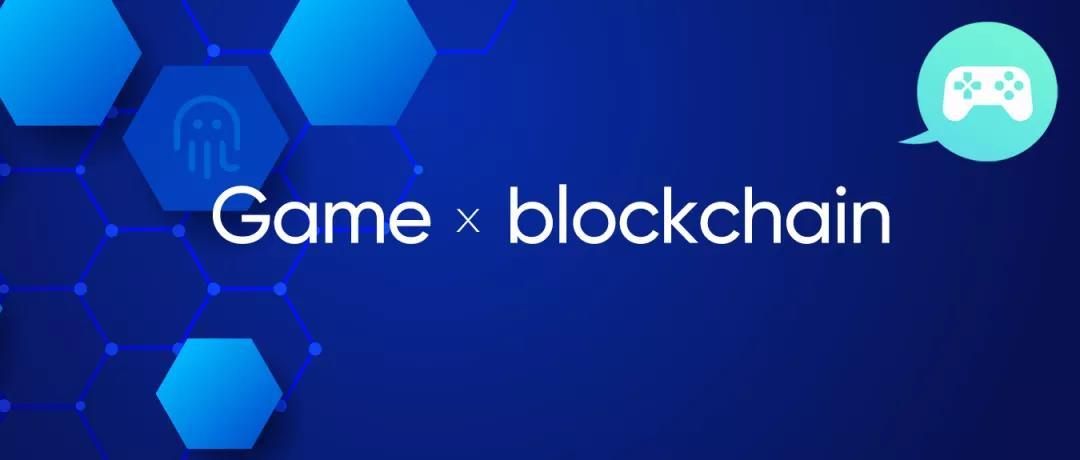
Good afternoon everyone, I am Louis, the co-founder of Octopus Network. I would like to thank Chain Teahouse for giving us the opportunity to discuss chain games with friends from the gaming and blockchain circles.
The topic I am sharing is "When Games Meet Blockchain": Simply put, I believe that the encounter between games and blockchain is a significant opportunity for both sides, allowing them to achieve mutual success. Currently, these two circles are quite isolated, and there are very few people who truly understand both games and blockchain, so it is essential for the two circles to communicate more. I am not a heavy gamer, so what I am discussing is from the perspective of the blockchain circle, and there may be inaccuracies; please feel free to correct me.
The Economic Paradigm of Chain Games: From "Closed Proprietary" to "Open Market"
We believe that chain games represent a transformation in the gaming economic paradigm, shifting from a closed proprietary economy to a truly open market. Previously, games were a service provided by game developers to players, namely the gaming experience.
The gaming experience may be enhanced by the participation of other players, representing a service-consumption model. Interaction between players is part of the gaming experience, but trading between game players is generally not supported, as it is seen as a loss of proprietary interests.
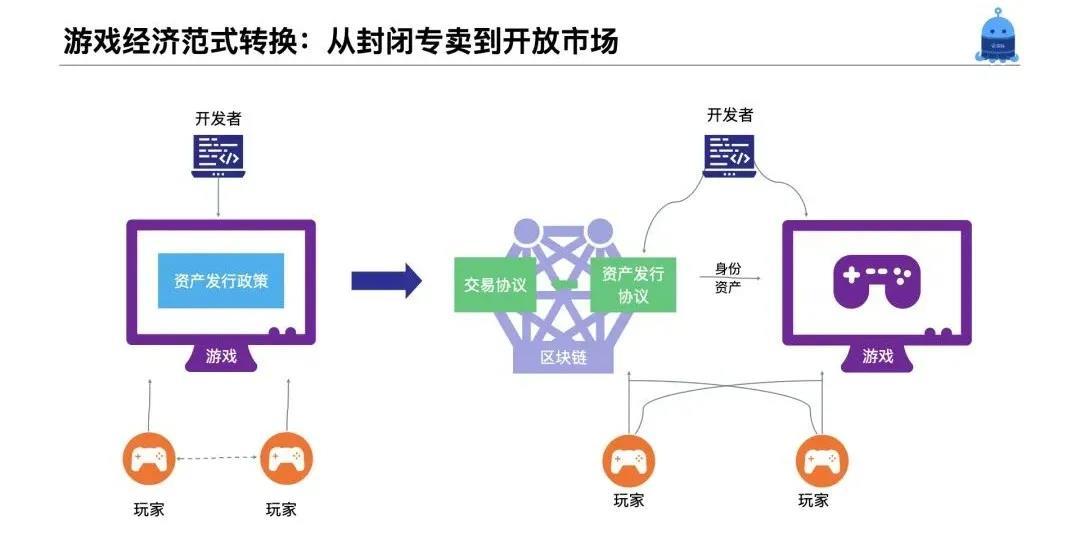
In the era of Web 3.0, there is an important change in chain games: the asset issuance policy of in-game assets, which was originally part of the game's value system, will be separated and placed on a public blockchain.
Once the asset issuance protocol is placed on a public blockchain, developers cannot easily modify the protocol. These in-game assets, whether interchangeable assets like coins or non-interchangeable assets like items and land, will become standardized tokens on the chain.
With asset issuance on the chain, any protocol on the chain can be used for trading. This means that all game assets become part of an open, vast, and unified market for crypto assets.
Games do not necessarily need to provide their own trading protocols. Generally speaking, the liquidity of an asset trading market created by a game cannot compare with that of a large market. As a game, the main business is to create gaming experiences. At the same time, the gaming experience relies on identities and assets on the chain. For players, on one hand, they interact with the game to consume the gaming experience, and on the other hand, they obtain assets by playing the game. Players' private keys directly control the gaming assets on the blockchain.
Therefore, chain games possess the two most important conditions for an open market economy:
The first is the property rights system. It is very clear who owns the assets. Players can dispose of their assets in any way they deem beneficial at any time, such as transferring or selling, without interference from others.
The second is that the various independent game economies have been interconnected by the blockchain, forming a huge, global, and low-friction unified market. This is very similar to the transformation of fragmented regional economies in feudal societies into a capitalist global market economy.
Tokenization of Chain Game Assets: Financial Utility and Application Utility
We say that a significant feature of chain games is asset tokenization. Turning game assets into tokens has two main meanings:
The long-term meaning is the change in ownership. Generally speaking, there will be an asset in chain games called governance tokens or ownership tokens, which represent ownership of the game economy. The incentive system of chain games should be designed around how to allocate ownership.
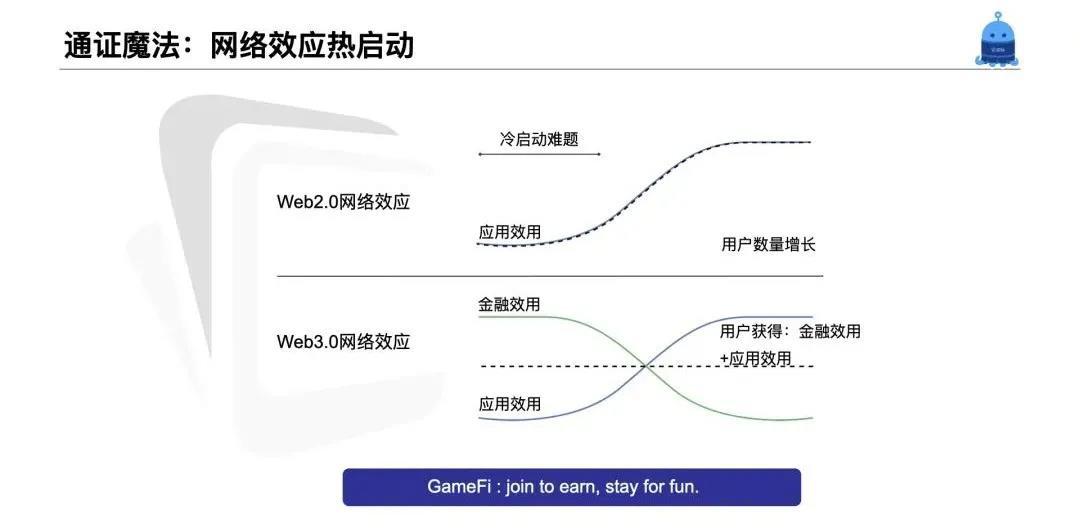
The short-term meaning of tokenization is what we call token magic. This is not only applicable to chain games but also to all Web 3.0 economies, helping platform-based economies complete the cold start process. Whether it is online games, chain games, or other platform-based economies, the core feature is the presence of network effects.
Network effects mean that the more users a platform has, the more valuable the platform's services become for each user. Network effects are a powerful phenomenon; the innovations in the IT field over the past few decades and the emergence of internet giants are all based on network effects.
However, initiating network effects is quite challenging because, at the beginning, the number of users is small, and the platform's application value to users is low. As the number of users grows, the application value increases slowly, and after reaching a critical scale, it grows rapidly.
Web 2.0 platform-based economies also face cold start problems, or the chicken-and-egg problem. The solution has typically been to raise funds through venture capital, then spend money on marketing and subsidizing users to kickstart network effects. In the era of Web 3.0, there is a new method and tool: tokens. The most important content in the white papers of Web 3.0 projects generally boils down to three points:
- What kind of decentralized platform economy to build
- How to launch the platform through token distribution
- How tokens capture the economic value of the platform
If these three points are persuasive, investors will recognize that the token has future value. In the financial market, assets that have future value are already valuable now and can be discounted based on risk-return ratios. Therefore, investors will seek to acquire tokens. Broadly speaking, investors do not necessarily have to spend money; they can also invest time and effort to obtain tokens.
Thus, tokens inherently possess financial effects from the very beginning. Although the application utility of the platform is relatively low, participants can earn tokens through usage. As the number of users increases, the application utility of the platform rises. If the application utility does not increase and only the financial utility exists, it becomes a Ponzi scheme.
As the scale of the economy expands, the risks borne by new users decrease, and their marginal contributions to network effect projects continue to decline. Therefore, the financial returns for new users should decrease, but they receive increasingly better application utility. This approach can more quickly leverage the Web 3.0 economy. The explosion of Axie Infinity is a typical example.
Token Economy Design of Chain Games: 3 Major Principles and 6 Bases
Regarding the token economy design of chain games, there are three basic assumptions that form the basis for subsequent discussions:
Chain games are virtual economies with player-to-player network effects.
Chain game assets must be issued as standard tokens on the chain.
The chain game economy is part of an open market for crypto assets.
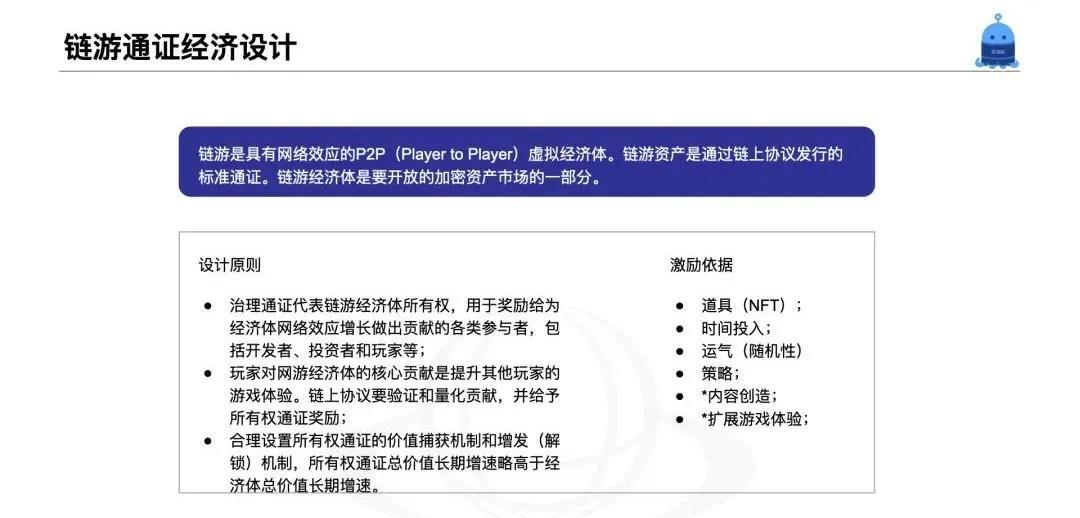 So, how do we design a chain game economy? Here are three design principles and six incentive bases for your reference.
So, how do we design a chain game economy? Here are three design principles and six incentive bases for your reference.
The core of the chain game economy is governance tokens or ownership tokens, which represent ownership of the chain game economy. This means both interests and rights. Interests must be transformed through mechanism design, turning the growth of the economy's scale into the growth of the intrinsic value of the tokens, also known as value capture. There are various methods for value capture, which cannot be detailed here.
Ownership tokens should be distributed to various participants who contribute to the growth of the economy's network effects, including developers, investors, and players, etc. Additionally, ownership tokens should have governance rights, allowing holders to participate in deciding the future direction of the chain game protocol, mainly the asset issuance protocol. The protocol can be improved and evolved through on-chain governance.
In the vast majority of game economies, game developers will still occupy a core position. In complex and continuously evolving game economies, the share allocated to developers cannot be too low. It is very irresponsible to give 100% of the tokens to the community right from the start, comparing it to a Fair Launch. If one merely forks an existing protocol, then all contributions actually come from the community, and in that case, giving 100% of the tokens to the community would be fair and reasonable.
The quality of mechanism design does not require moral consideration. Is it fairer if developers receive less? It is not that simple. The goal of mechanism design is to be long-term incentive compatible. It should motivate everyone to do things that benefit the development of the economy in the long run. Furthermore, investors who buy in either the primary or secondary market, providing funds, should also receive tokens.
The key is how to reward players. Players' core contribution to the chain game economy is enhancing the gaming experience of other players. If someone buys an item NFT and then sells it, they are an investor, not a player. Players must participate in the game to enhance the gaming experience of others to make their rightful contribution as players. This contribution needs to be verifiable and quantifiable on the on-chain protocol, which is the core of the design of the chain game economic system.
The incentive basis for rewarding players' contributions should consider several factors:
The first is identity and items; who they are and their attributes, which also includes the player's past contributions to the economy.
The second is the time invested; all rewards must be time-related; otherwise, the game will fast forward. The third is randomness, as randomness itself is part of the fun of the game.
The fourth is strategy, or skill, as there are currently very few real-time chain games, so it is also appropriate to refer to skill as strategy. Strategy refers to the methods used in participation and competition. Strategies can be individual or collective, and collective strategies require cooperation, rewarding various collaborations that generate society.
Additionally, there should not be an absolute optimal strategy from the beginning. The outcome of a strategy should depend on the strategies of other players or teams during the same time period. This is how complex systems can be formed, allowing for self-organization and self-evolution. Once there is an absolutely rational optimal strategy, both players and player teams will ultimately lose their free will and become slaves to algorithms, and the meaning of the game will disappear.
The last two points are content creation and expanding the gaming experience. Advanced games should support players in contributing content and expanding the gaming experience. On one hand, this requires support from the gaming technology platform, and on the other hand, contributions of content or new gaming experiences are not easy to evaluate. Hence, I marked this with an asterisk, as it is a more advanced concept.
The final major principle is: it is necessary to reasonably set the value capture mechanism and the issuance unlocking mechanism for ownership tokens, ensuring that the total value of ownership tokens grows slightly faster than the token issuance rate in the long term. The implicit meaning is that the intrinsic value of a unit of ownership token should grow over the long term.
In the crypto asset market, if tokens lose their value storage utility, those who acquire them will quickly sell them off. If no one is willing to hold the tokens, all token economic designs will fail. So why not set the issuance rate as low as possible? Because a low issuance rate means being overly favorable to early participants, which raises the costs for later participants.
The Ceiling of Chain Game Economy: Public Chain Transaction Processing Capacity
In the second half, we will discuss the infrastructure of chain games. 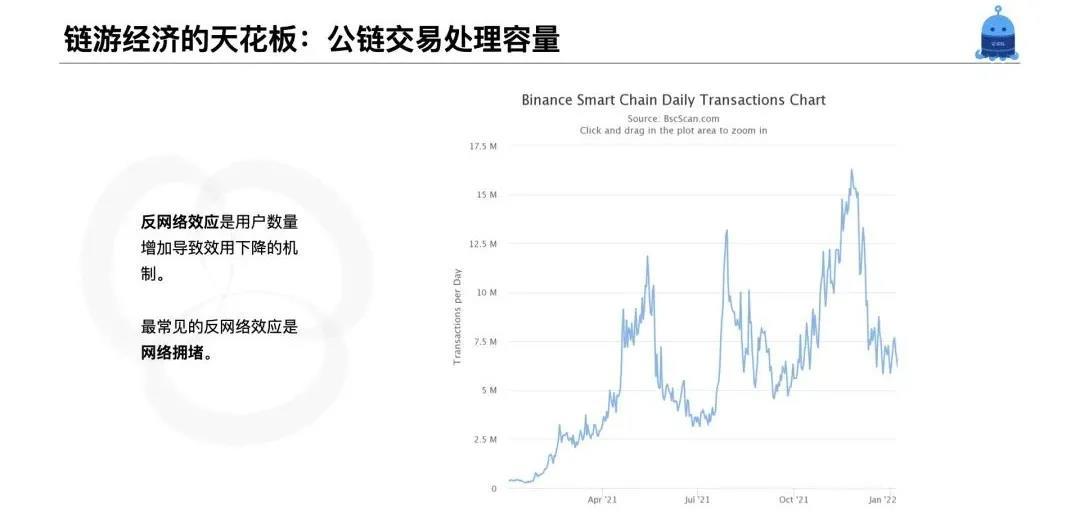 The above chart is quite simple; it shows the daily transaction volume of BSC over the past year. On average, it is around several million transactions per day, with peaks exceeding 10 million. This is generally recognized as the number of transactions that a fast public chain can support. At the end of last year, there was significant congestion, mainly due to chain games. When daily transaction volume exceeds 10 million, congestion becomes quite serious.
The above chart is quite simple; it shows the daily transaction volume of BSC over the past year. On average, it is around several million transactions per day, with peaks exceeding 10 million. This is generally recognized as the number of transactions that a fast public chain can support. At the end of last year, there was significant congestion, mainly due to chain games. When daily transaction volume exceeds 10 million, congestion becomes quite serious.
The biggest ceiling for the chain game economy is likely the capacity of the blockchain. We refer to this as the anti-network effect, where the more users there are, the lower the value for each individual user due to congestion.
What can be done? The only way to run large-scale chain games is through application chains, one chain for one game. At the level of Axie, it can have 1 million active users, with daily transaction volumes in the millions or even tens of millions. A game of this scale can exhaust the entire capacity of the BSC public chain, making it unsustainable to run chain games on a public chain.
Do not only look at the current Gas fees. The Gas fees of blockchains do not increase linearly. When Ethereum processes a few hundred thousand transactions per day, the Gas fees are not high at all. However, when it reaches seven or eight hundred thousand transactions per day, and the capacity approaches saturation, the Gas fees do not just increase several times; they can increase dozens of times. This is similar to traffic congestion; when there are few cars, everyone drives smoothly, but after reaching a certain critical point, the average speed of travel drops significantly, and everyone struggles to move.
EVM-Compatible Application Chains: The Most Suitable Technology Stack for Chain Games

We believe that the most suitable technology stack for chain games is EVM-compatible application chains. Why EVM-compatible? Because there are many blockchain development technologies, but EVM is the absolute mainstream. The most direct issue is that when developing chain games, you need to find smart contract developers. The ones you find will mostly be Solidity programmers, and very few will understand other technology stacks. Moreover, EVM has matured over seven years, and all the pitfalls have been addressed.
An application chain is one chain for one application. Although developed using smart contracts, it can still enjoy the benefits of one chain for one application. First, it exclusively enjoys the processing power of a single chain. Application chains, due to having fewer nodes, can exceed the performance of ordinary public chains, processing tens of millions of transactions per day, supporting chain games to achieve millions of daily active users.
Additionally, you do not have to worry about competing with other applications. If you are on a large public chain, it is possible that after you conduct a successful marketing campaign, other applications start doing airdrops, and you find that users cannot enter at all. Such situations frequently occur on Ethereum and EOS. Compared to DeFi, chain games have a higher interaction density and lower unit transaction value. Therefore, once a large public chain becomes congested, chain games are the first to suffer, as most chain game users are price-sensitive.
The second advantage is that application chains are specifically designed to serve a particular application. They can be fully customized to achieve the best user experience. Everyone knows that the explosion of Axie Infinity occurred around March and April of last year.
The most important opportunity was the launch of the dedicated sidechain Ronin. After Ronin went live, it effectively reduced the transaction costs of Axie to nearly zero, triggering a massive explosion. Axie started in 2018, and the entire technical development was quite tumultuous; ultimately, they had to develop Ronin themselves.
The term Ronin means a masterless samurai. Axie named this sidechain Ronin to signify that they control the infrastructure and are not subject to others. The entire chain serves a single application, allowing for upgrades. On any public chain, if a certain application requires the public chain to upgrade, that is impossible.
Octopus Network: One-Stop Infrastructure Service
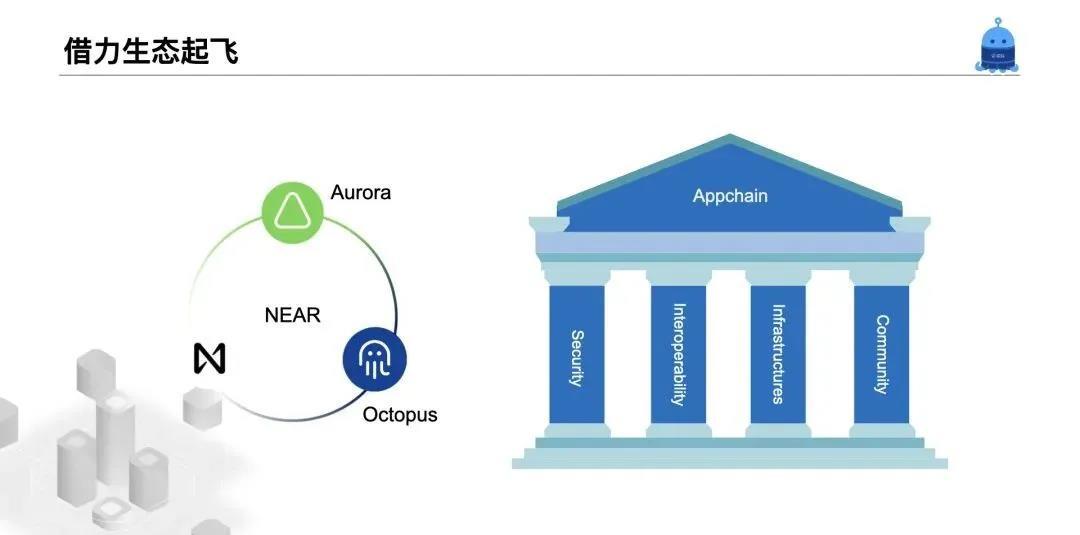
Our Octopus Network belongs to the NEAR ecosystem. NEAR is a fantastic public chain. By the end of 2021, it was one of the best-performing crypto projects. Its ranking surged from over 40 to the top 20, with a market cap of 11 billion dollars, which can be seen as a result of accumulated strength. The core team of NEAR is a very strong technical team. The sharding led by NEAR is the most complex but has the greatest potential for scalability in blockchain technology.
The NEAR ecosystem also has a development triangle. In addition to NEAR's native smart contract development, it also supports AURORA's EVM development. The main goal is to make it very easy to port Ethereum's DeFi protocols.
The third corner is OCTOPUS Network, which is an application multi-chain network built around NEAR. Each application chain is an independent chain with dozens of nodes. The application chain has seamless cross-chain capabilities with the NEAR main chain and can perform bidirectional asset cross-chain with Ethereum.
The success of application chains requires four pillars: the first is security, so that users can confidently store assets on the chain or transfer them across chains. Octopus Network provides rental security (LPoS), which is on-demand security with controllable costs, and the level of security increases as the economic scale of the application chain expands.
The second is cross-chain capabilities; Octopus application chains and NEAR are inherently cross-chain and can cross-chain with Ethereum through the Rainbow Bridge. We have developed Substrate IBC, allowing Octopus application chains to connect to Cosmos through IBC. The third is infrastructure; Octopus Network provides a complete set of infrastructure services. The application chain team only needs to focus on the application and frontend, while everything else, including nodes, blockchain explorers, RPC clusters, Indexers, etc., is provided for free by Octopus Network.
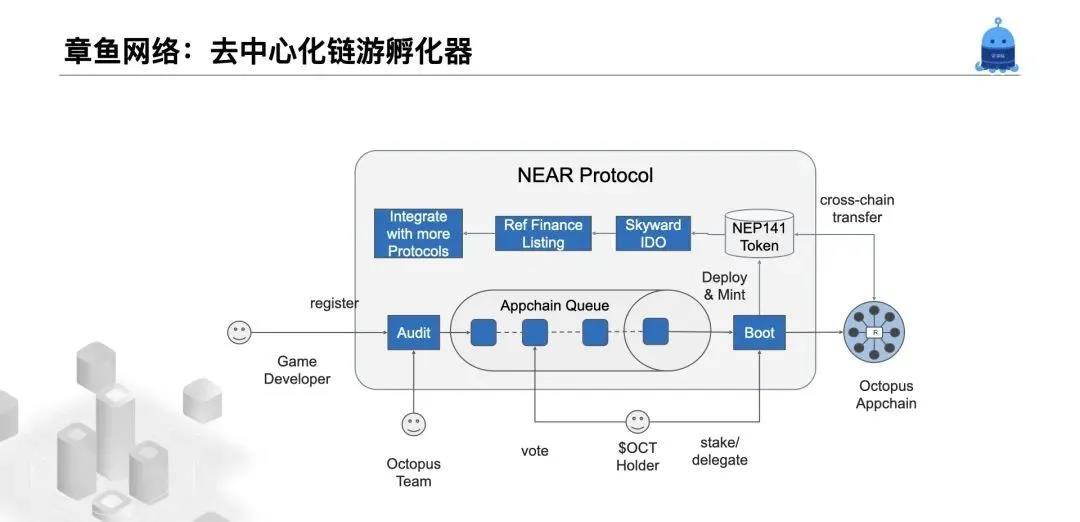
For various Web 3.0 applications, including chain games, the most important thing is to develop their own community. Now, when doing chain game projects, it is essential to choose to join a good ecosystem, receive support from the ecosystem, and gain community attention; otherwise, no one will pay attention to what you are doing. Octopus Network can be seen as a decentralized incubator.
The team should focus on development and register with Octopus Network. After we conduct a technical review, there will be an open voting mechanism to seek support within the Octopus Network community. We will help promote the game within the community. Periodically, the application chain that receives the most support will launch its mainnet.
Currently, Octopus Network has launched two application chains and will continue to launch one every two to three weeks. The Octopus application chains and NEAR are inherently cross-chain. Native tokens can be cross-chained to NEAR for IDO.
For the first ten application chains that join, Octopus Network will provide 200,000 OCT tokens as airdrops for their investors during IDO, helping the application chains raise approximately 1 million dollars. Then they can trade on Ref.finance, as they are standard tokens and can be combined with all NEAR DeFi protocols.










